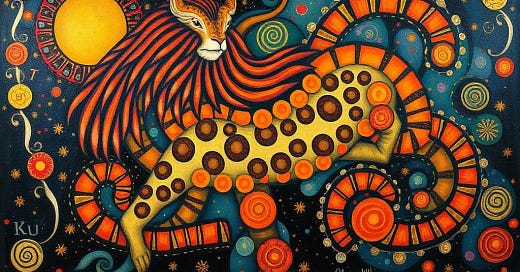Rahu and Ketu: The Profound Meaning of the Lunar Nodes in Vedic Astrology
Discover what the lunar nodes are and how their energies of desire and detachment drive the perpetual flow of life.
Have you ever felt an insatiable desire within you, one so intense that nothing seemed to satisfy it? Or perhaps you've experienced a moment when something you once valued suddenly lost its importance. These sensations might reflect the energy of the lunar nodes: Rahu and Ketu. In Vedic astrology, these nodes carry deeply symbolic meanings rooted in mythology and the concept of polarities. Unlike modern interpretations, which often see them as points of personal evolution or spiritual growth, ancient traditions describe them as eternally separated forces that generate perpetual tension and movement. This perspective highlights their role as drivers of change, experience, and liberation.
If you’ve ever wondered what the lunar nodes are or what Rahu and Ketu mean, this article will provide an explanation rooted in Vedic astrology and its profound symbolism.
The Mythical Origin: The Legend of Rahu and Ketu
The story of Rahu and Ketu originates in the Hindu myth of Samudra Manthan, or the Churning of the Ocean of Milk:
The Nectar of Immortality: The gods (Devas) and demons (Asuras) worked together to churn the ocean in search of Amrita, the nectar of immortality.
The Deception of the Asura: When the Amrita finally appeared, the gods attempted to prevent the demons from drinking it. However, an Asura disguised as a god managed to infiltrate and consume a small amount of the nectar.
The Separation: Vishnu, upon discovering the deception, severed the Asura in two with his celestial disc, the Sudarshan Chakra. Although divided, the two parts survived because the Asura had already ingested the nectar:
Rahu: The head of the Asura, symbolizing insatiable desire and attraction.
Ketu: The tail of the Asura, representing detachment, liberation, and dissolution.
This eternal separation between Rahu and Ketu defines their nature: two complementary yet severed forces, incapable of reuniting. Instead of seeking integration, they generate dynamic tension that drives change and evolution.
Rahu: The Head of the Dragon
Essential Symbolism
Desire and Craving: Rahu represents insatiable desire, the urge to pursue the unknown and the unattainable. It is the part that “devours” but is never satisfied.
Illusion (Maya): Rahu is associated with illusion, with things that appear real but are not entirely so. It symbolizes attraction to the material world and experiences that are fascinating but ultimately unfulfilling.
The Unknown Future: Rahu points toward what lies ahead, what we need to explore but have yet to master.
Energy in Action
Rahu is disruptive and chaotic. It does not follow rules or structures; its purpose is to break patterns and explore uncharted territories.
It embodies pure ambition without clarity, seeking without fully understanding what it seeks.
This energy symbolizes the drive to chase the new and the unknown, propelling us forward without guarantees of satisfaction.
Ketu: The Tail of the Dragon
Essential Symbolism
Detachment and Liberation: Ketu represents letting go, the ability to release what no longer serves or what has already been mastered. It is Rahu’s counterpart: where Rahu desires, Ketu cuts.
Accumulated Wisdom: Ketu is connected to the past, to what has been learned and experienced. It represents karmic memory and prior lessons.
Spirituality and Transcendence: As the tail, Ketu has no “head” to desire. Its energy is introspective, connected to the intangible and the spiritual.
Energy in Action
Ketu dissolves the ego and material attachments. Wherever it appears, it invites us to abandon or transcend.
However, it can also create confusion or disconnection, as its nature is to release, which can be challenging for the psyche.
Ketu symbolizes the realization that material pursuits no longer satisfy. It is a force of liberation that pushes us inward, transcending the external to find meaning in the intangible.
The Rahu-Ketu Axis: Separation and Tension
The myth establishes that Rahu and Ketu are eternally separated, and this separation is key to understanding their energy:
Rahu and Ketu can never reconcile or integrate. They function as opposing forces that generate perpetual movement.
This axis does not seek balance but instead creates dynamic tension essential for evolution, change, and energetic flow.
Essential Polarities
Rahu (Attraction to the New): Pushes us forward, toward the unknown, what we have not yet experienced or mastered.
Ketu (Detachment from the Past): Pulls us inward, toward what we already know, but also toward letting go of what no longer serves.
This axis represents a constant dynamic between desire and renunciation, an oscillation that drives transformation on both individual and collective levels.
Conclusion: The Essential Meaning of the Lunar Nodes
In ancient tradition, Rahu and Ketu do not represent integration or stability but rather tension and movement. They are complementary forces that drive change, keeping us in a perpetual flow between craving the new and releasing the old. This perpetual dynamic is what creates the motion necessary for experience, evolution, and transformation.
If you seek to understand what Rahu and Ketu mean in your life or how the lunar nodes act, remember that these points reflect forces that constantly challenge us. Rahu is the insatiable desire that propels us toward the future. Ketu is the wise detachment that connects us to the eternal. Together, they are the engine that sustains the constant expansion of life.





